We Tested the Solo Stove Pi Pizza Oven—and Highly Recommend It
Dotdash Meredith and Yahoo Inc. may earn commission or revenue on some items through the links below.
Both the wood-fired and gas burners reached amazingly high temperatures.
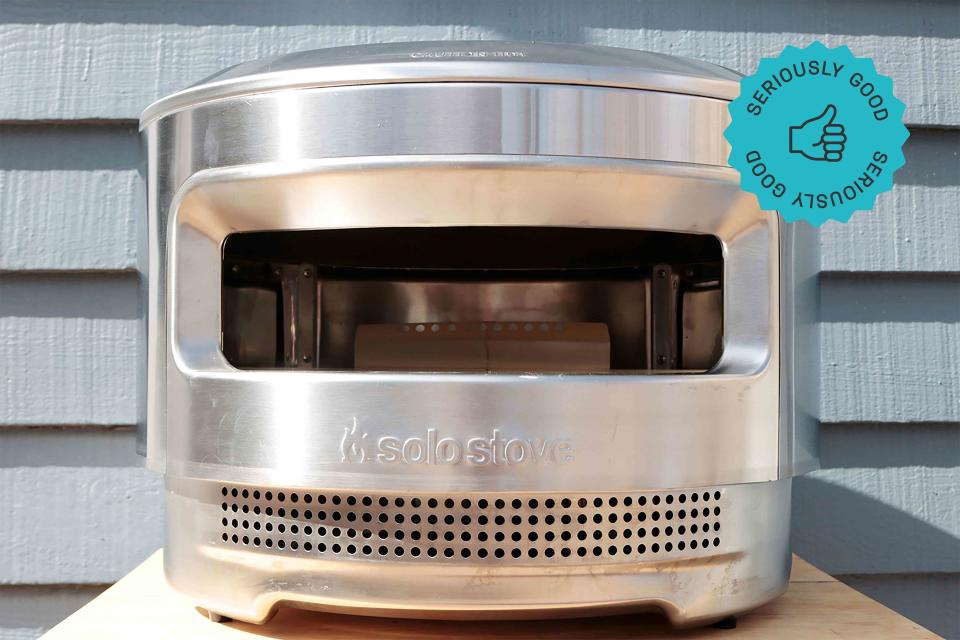
Serious Eats / Jesse Raub
The Solo Stove Pi Pizza Oven delivers top notch heat using both wood and gas and cooked perfect pizzas in under two minutes.
I pride myself on being a dough aficionado, making pizza on a near-weekly basis. And while I’ve mastered cast-iron pan pizza, al taglio-style rectangular pies, and home-oven hacks, I was intrigued by the Solo Stove Pi Pizza Oven and its advertised high-temperature range—the first standalone pizza oven from company behind the drum-like Solo Stoves.
Neapolitan pizza requires extremely high-temps (over 1000ºF in the dome), and the multi-fuel source Solo Pi had the potential to deliver these crust-blistering blazes right in my backyard. I set out to test both the wood-fired burner and gas burner to see if either could deliver like a true Neapolitan oven.
The Tests
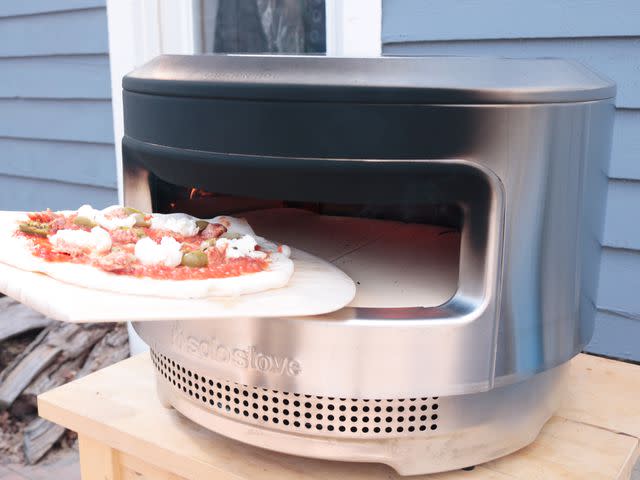
Serious Eats / Jesse Raub
Wood-Fired Pizza Tests: I followed the recipe for Outdoor Pizza Oven Dough and made multiple sausage and olive pizzas using wood as the fuel source.
Gas Burner Pizza Tests: I followed the recipe for Outdoor Pizza Oven Dough and made multiple sausage and olive pizzas using the gas burner as the fuel source.
Usability and Cleanup Tests: I took note of how simple the oven was to set up and switch between fuel sources, how easy it was to light and cook pizzas, and how easy it was to clean when pizza launching went awry.
What We Learned
It Got Really Hot—Especially in Gas Mode
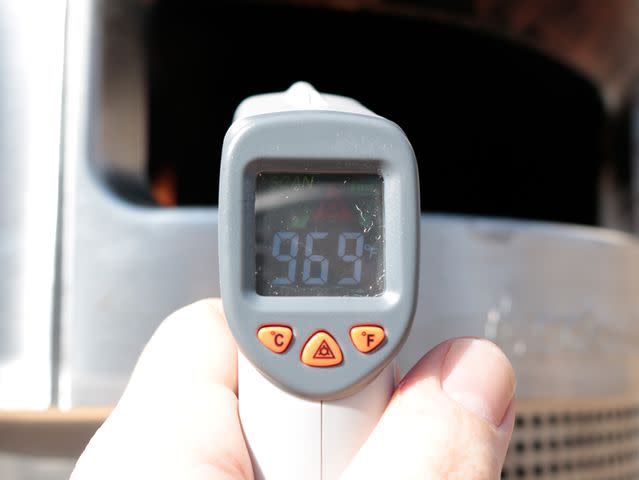
Serious Eats / Jesse Raub
Around 20 minutes after I lit the oven using a small pile of wood and some newspaper, the stone in the Pi hit 500ºF, while the dome registered around 650ºF. After stoking the fire with a few more pieces of wood, those temps climbed to 600ºF on the stone and 800ºF in the dome—hot enough to cook a pizza in around four minutes.
Read More:We Tested the Solo Stove Bonfire Fire Pit to See if You Should Buy (And Cook On) One
The next day, when I swapped out the ashtray in the back for the gas burner, the temperatures were even more impressive: in around 25 minutes, the stone hit 750ºF while the dome was near 1000ºF—right in the range we recommend for Neapolitan-style pizza, and higher than the 900ºF max temp Solo Stove advertises. It was truly an impressive heat generator, and quick, too. After it cooled slightly, I cooked pizzas in about one-and-a-half minutes with a nice char on the surface and crust.
The Demi-Dome Construction Directed Heat Nicely
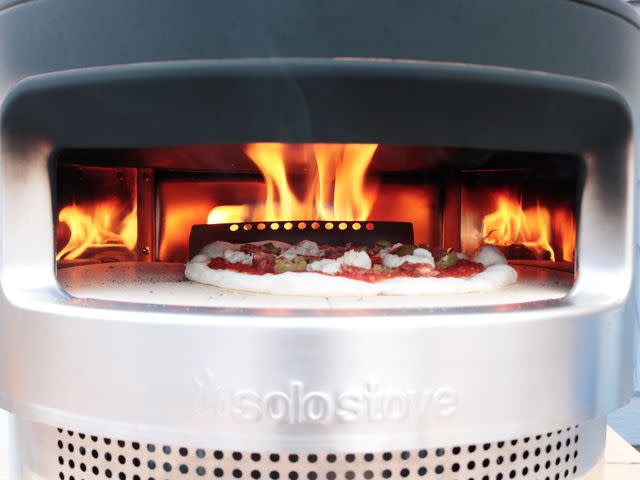
Serious Eats / Jesse Raub
Flames curving around the demi-dome over the top of a pizza.Looking inside the Pi, you can see what they call the demi-dome construction. While the ceiling in the front of the oven is fairly parallel to the stone, the back of the oven slopes more aggressively towards the flames. When the flames get high enough, this slope actually curves them up and over the stone itself, giving a direct heat source over the pizza. This is key: while the stone speedily bakes the bottom of the crust, the overhead flames cook the top of the pie at the same rate. Without this directional heat, it would take much longer for the cheese to melt, and the top of the crust to char.
It Had Incredible Heat Retention
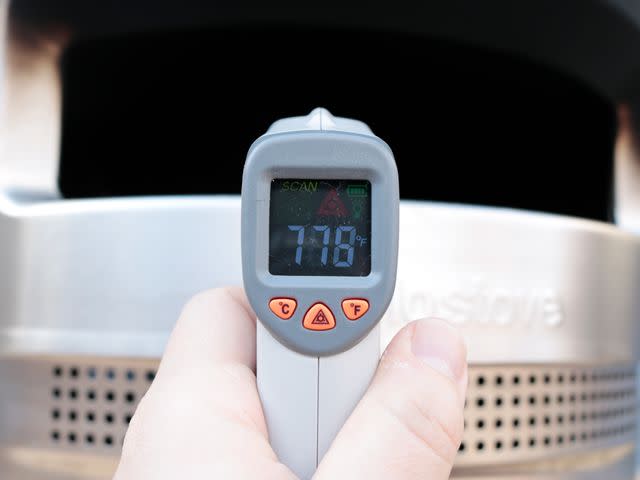
Serious Eats / Jesse Raub
Ten minutes after cutting the flame, the dome still held onto high temperatures.What was really mind-boggling was how well-insulated the whole pizza oven was. Because it’s made of double-walled stainless steel the way their fire pits are, it was able to hold heat very well. For example, even when the wood fire died down and the stone began to cool, the oven stayed quite hot—the dome charted 800ºF temperatures even when the stone had dropped to 350ºF.
The Flame Barrier Was Tricky to Work Around
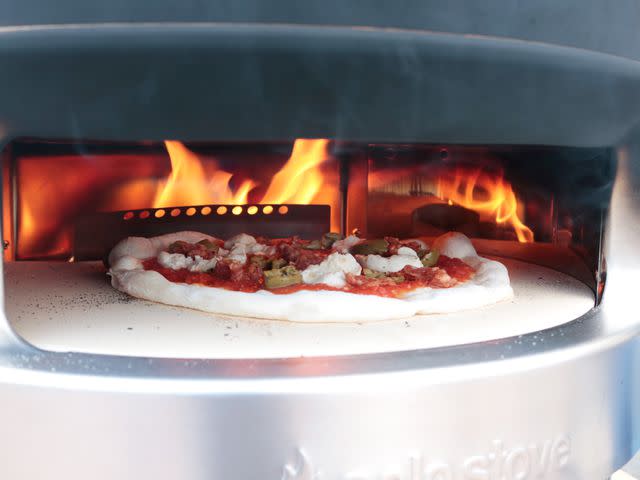
Serious Eats / Jesse Raub
Launching pies took precise aiming to avoid bumping into the metal flame barrier.The stone for this oven comes in two pieces and is a slightly odd shape: while the front is round, the backside is flat where it meets the stainless barrier that directs flames up towards the dome. The first pizza I launched in the oven had too much momentum and squished itself up against that wall. It can be a little tricky to eyeball exactly where the center of its 12-inch cooking surface is, but with some practice, I got perfectly round pies.
The Panoramic Opening Made It Easy To Turn Pizza
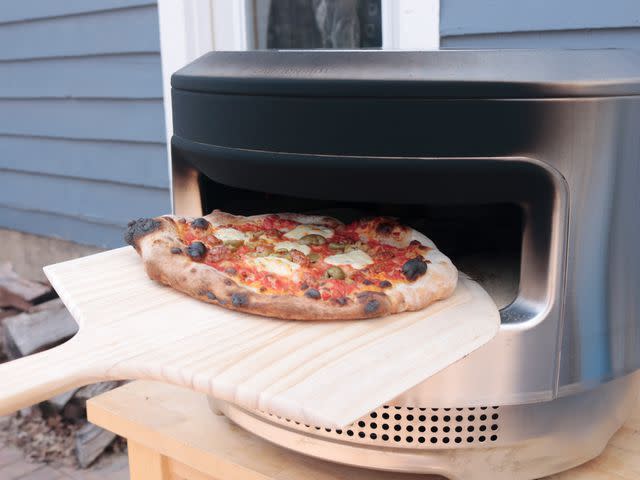
Serious Eats / Jesse raub
Another reason why it was difficult to gauge the center of the cooking surface was the oven’s 13-inch panoramic opening, which opens outward and wider than the diameter of the stone itself. While it created a wider impression of the cooking surface, it also helped me turn the pies much easier than other outdoor pizza ovens, which often have openings that are the width of the stone. So while it was harder for me to judge exactly where to launch the pizzas, it was easier to get the peel back in there and correct the positioning.
It Was Easy (and Fast) to Switch Fuel Sources
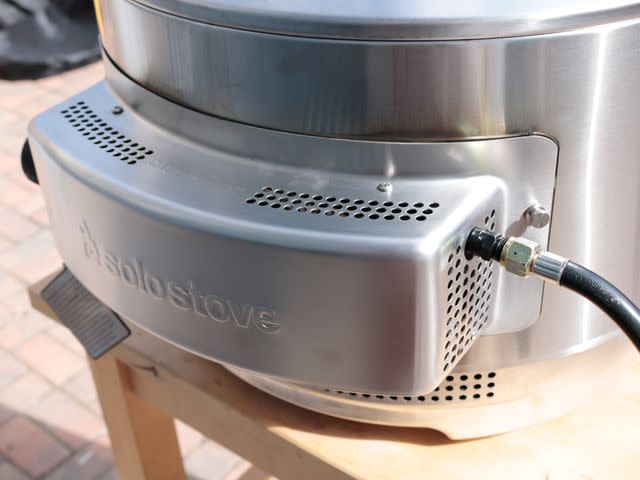
Serious Eat / Jesse Raub
Only two thumbscrews were needed to swap the wood burning chamber for the gas burner.On day two of testing, it was time to swap to the gas burner. The Pi comes with a handle that slots into the insulated back panel for easy burner removal, and the ash can pops out for easy disposal. After that, the gas burner attachment slots in to replace the back panel, and is secured to the oven with two thumbscrews. Connect the hose to a propane tank, and the whole swap took less than five minutes. Before I started testing the Pi, I assumed I’d enjoy one fuel source more than the other and park it in that mode. But with the switch being that quick, I could see myself swapping in the gas burner for backyard pizza parties when I need longer, sustained heat, and switching it back to the wood-fired mode if I wanted to bring the oven to a campsite or the beach.
It Was Compact and Lightweight
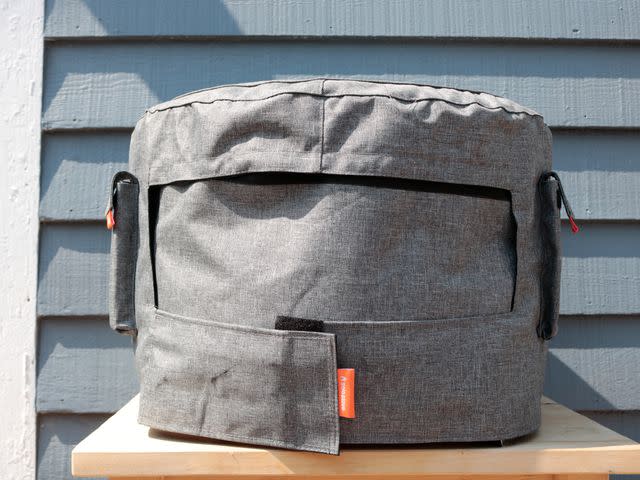
Serious Eat / Jesse Raub
The all-weather cover protected the oven from snow and sun, though it's lightweight enough to bring indoors for winter.Okay—maybe camping and the beach are a stretch, but the Solo Stove Pi is compact and lightweight compared to other outdoor pizza ovens. At just 20 inches in diameter and 30 pounds, it’s not impossible to see myself packing it in my car’s trunk for a trip. In comparison, one of our favorite outdoor pizza ovens, the Gozney Roccbox, weighs 50 pounds. However, the Pi is a little heavier than the Ooni Karu 12 Multi-Fuel Oven, which is only 26 pounds. And even though the all-weather cover is thoroughly effective against rain and snow (our backyard got dumped on the day after testing), having a smaller, lightweight pizza oven is great for moving into the basement for the colder months.
Cleanup Was A Cinch—Thankfully!
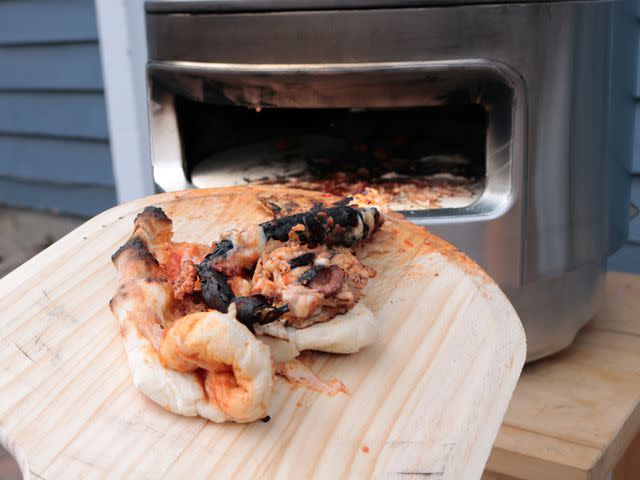
Serious Eats / Jesse Raub
When the pizza flipped over, the stone charred cheese and sauce immediately. Thankfully, it was easy to clean off once it cooled.While the oddly-shaped stones made it tricky to launch pizzas, it also made them extremely easy to pull out for cleaning—which was a massive relief when the last pie flipped face down directly onto the stone when I tried to launch it. After letting cheese and sauce burn off and the oven cool down, the back panel was easy to remove and the stones could be pulled out and scraped clean without hassle. Since the rest of the oven is stainless steel, you can wipe it clean with a damp cloth.
You Could Taste The Difference
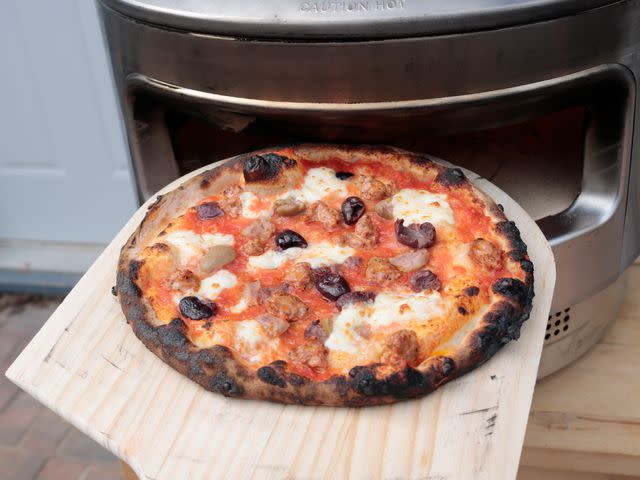
Serious Eat / Jesse Raub
Even with an aggressive char, the crust was tender and chewy inside.And finally, to the finished product: the pizzas themselves. I invited some friends over to taste pizzas made in the Solo Stove Pi, and it was unanimous: the Pi's pies were phenomenal. With a super high temp and fast cook time, the Solo Stove Pi’s pizzas were tender, light, and chewy without sacrificing the depth of flavor that comes from deep caramelization in the crust. While the wood-fired pizzas had a tinge of smoky flavor that added some character, the gas-fired pies benefited from higher temperatures. Those pizzas were cooked in half the time (two versus four minutes), and the contrast between the soft crust interior and crisp exterior was more noticeable.
The Verdict
Solo Stove Pi Pizza Oven

If you're looking for a multi-fuel pizza oven that can hit high-temperatures with excellent heat retention, the Solo Stove Pi Pizza Oven fits the bill. It’s lightweight (which makes it easy to store or transport), cooks delicious pies, and can be cleaned with little effort.
Pros
The Solo Stove Pi can easily switch between its wood-fired and gas burners in just five minutes, and its compact size and light weight makes it easy to store when not in use. Its wood burner can heat the oven to 800ºF, while the gas burner is able to hit over 1000ºF and cook pizzas in under two minutes. The demi-dome ceiling directs the flame over the top of the pies for excellent char, while the wide-opening makes it easy to turn pies mid-cook. Its dual-wall stainless steel construction retains heat well and cleans up easily, and above all else, it cooks delicious pizza.
Cons
The biggest issue with the Solo Stove Pi is the oddly shaped pizza stone. It can be tricky to center pizzas correctly, though that’s easy to fix with practice. The stone also loses heat quickly if the wood flame dies down, so managing temperature requires your full attention. I also wished there was a larger option: this model can only fit a 12-inch pizza, which can slow things down if you’re cooking for a crowd. And while the price is comparable to other outdoor pizza ovens, it is expensive.
Key Specs
Overall dimensions: 20-inch diameter; 15 inches high
Weight: 30 pounds
Materials: Stainless steel; cordierite stone
Opening dimensions: 13 inches wide
Stone dimensions: 12-inch diameter cooking surface
Stone thickness: 13 millimeters
Compatible cover: Pi Shelter
Price at time of publish: $440 for the wood-fired option ($175 to add the gas burner on later), $710 for the dual fuel bundle that also includes a peel, an infrared thermometer, and a pizza cutter
A Note About The Solo Stove Yukon Pi Fire

We also tested the Solo Stove Pi Fire Pizza Oven, a pizza oven attachment that fits over all three sizes of Solo Stove fire pit. We’ve previously really liked Solo Stove attachments, so we wanted to try this one too. While we were able to cook a few nice pizzas on the Pi Fire, they were comparable to using a stone in a home oven and more pale on top than we'd have liked, as the ceiling was too vented and consistently 100ºF cooler than the stone itself. However, if you already own a Solo Stove and want a portable pizza oven attachment for camping, tailgating, etc, you may like the Pi Fire.
FAQs
Is the Solo Stove Pi worth it?
The Solo Stove Pi Pizza Oven is priced similarly to other outdoor pizza ovens and offers excellent heat distribution along with incredible heat retention. It’s also smaller and lighter than some other outdoor pizza ovens, making it more portable. It’s a great choice for people who want a pizza oven they can bring to a friend’s house and can cook some truly excellent pies.
Can you cook pizza on a Solo Stove fire pit?
Solo Stove does offer an over-the-fire-pit attachment called the Solo Stove Pi Fire Pizza Oven. In our testing, the stone got hot enough for a crisp crust, but the dome vented too much heat, leaving the top side of each pizza pale. We prefer the Solo Stove Pi Pizza Oven, which has a dual heat source, and a demi-dome construction that cooks the tops of pizzas perfectly. If you already have a Solo Stove and are interested in the attachment, however, it does work and may be worth checking out.
How long does it take to cook pizza in the Solo Stove Pi?
Once it’s fully preheated the pizza stone to 700ºF pizza and the dome to 900ºF, the Solo Stove Pi can cook a pizza in one-and-a-half to two minutes—that’s fast! If the stone is only around 600ºF with an 800ºF dome, we found it took closer to four minutes for a pizza to fully cook. While it was easy to know when a pizza was finished cooking, using an infrared thermometer (that is included in some bundles) was key for knowing the right time to fire your pies.
How hot does the Solo Stove Pi get?
In wood-fired mode, we found the Solo Stove Pi dome reached 800ºF with the stone at 600ºF, though it’s likely that careful fire building and better timing could get those temperatures a little higher. In gas burner mode, the Solo Stove Pi dome easily hit over 1000ºF and the stone hit 750ºF—right in the range we recommend for Neapolitan-style pizza.
Read More:Which Ooni Pizza Oven Should You Buy? We Compared Them All

